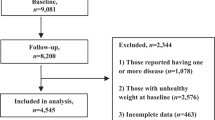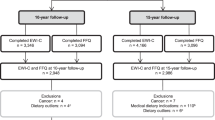Abstract
Objective:
To investigate potential personal, social and physical environmental predictors of daily fruit intake and daily vegetable intake in 11-year-old boys and girls in nine European countries.
Subjects:
The total sample size was 13 305 (90.4% participation rate).
Results:
Overall, 43.2% of the children reported to eat fruit every day, 46.1% reported to eat vegetables every day. Daily fruit intake and daily vegetable intake was mainly associated with knowledge of the national recommendations, positive self-efficacy, positive liking and preference, parental modeling and demand and bringing fruit to school (odds ratio between 1.40 and 2.42, P<0.02). These factors were associated fairly consistently with daily fruit intake across all nine European countries, implying that a rather uniform intervention strategy to promote fruit can be used across Europe. For vegetables, the pattern was, however, less consistent. Differences between countries in cooking and preparing vegetables might be responsible for this larger diversity.
Conclusions:
This study showed that especially a combination of personal and social factors is related to daily fruit and vegetable intake in schoolchildren. This shows that a comprehensive multilevel intervention strategy based upon a series of individual and social correlates will be most promising in the promotion of daily fruit and vegetable intake in children.
This is a preview of subscription content, access via your institution
Access options
Subscribe to this journal
Receive 12 print issues and online access
$259.00 per year
only $21.58 per issue
Buy this article
- Purchase on Springer Link
- Instant access to full article PDF
Prices may be subject to local taxes which are calculated during checkout
Similar content being viewed by others
References
Armitage CJ, Conner M (2000). Social cognition models and health behaviour: a structured review. Psych Health 15, 173–189.
Baranowski T, Lin LS, Wetter DW, Resnicow K, Hearn MD (1997). Theory as mediating variables: why aren’t community interventions working as desired? Ann Epidemiol 7, s89–s95.
Bere E, Klepp KI (2004). Correlates of fruit and vegetable intake among Norwegian schoolchildren: parental and self-reports. Public Health Nutr 7, 991–998.
Birch LL (1990). Development of food acceptance patterns. Dev Psych 26, 515–519.
Birch LL, Fisher JO (2000). Mothers’ child-feeding practices influence daughters’ eating and weight. Am J Clin Nutr 71, 1054–1061.
Bogers RP, Brug J, van Assema P, Dagnelie PC (2004). Explaining fruit and vegetable consumption: the theory of planned behaviour and misconception of personal intake levels. Appetite 42, 157–166.
Brug J, van Lenthe FJ (2005). Environmental Determinants and Interventions for Physical Activity, Nutrition and Smoking: A Review. Den Haag, ZonMW.
Cullen KW, Baranowski T, Owens E, Marsh T, Rittenberry L, deMoor C (2003). Availability, accessibility, and preferences for fruit, 100% fruit juice, and vegetables influence children's dietary behaviour. Health Educ Behav 30, 615–626.
Cullen KW, Baranowski T, Rittenberry L, Cosart C, Hebert D, deMoor C (2001). Child-reported family and peer influences on fruit, juice and vegetable consumption: reliability and validity of measures. Health Educ Res 16, 187–200.
De Bourdeaudhuij I, Klepp KI, Due P, Perez Rodrigo C, de Almeida MDV, Wind M et al. (2005). Reliability of a questionnaire to measure personal, social and environmental correlates of fruit and vegetable intake in 10–11 year old children in 5 European countries. Public Health Nutr 8, 189–200.
De Bourdeaudhuij I, Van Oost P (2000). Personal and family determinants of dietary behaviour in adolescents and their parents. Psychol Health 15, 751–770.
Domel SB, Thompson WO, Davis HC, Baranowski T, Leonard SB, Baranowski J (1996). Psychosocial predictors of fruit and vegetable consumption among elementary school children. Health Educ Res 11, 299–308.
Gibson EL, Wardle J, Watts CJ (1998). Fruit and vegetable consumption, nutritional knowledge and beliefs in mothers and children. Appetite 31, 205–228.
Hanson NI, Neumark-Sztainer D, Eisenberg ME, Story M, Wall M (2005). Associations between parental report of the home food environment and adolescent intakes of fruits, vegetables and dairy foods. Public Health Nutr 8, 77–85.
Haraldsdóttir J, Thórsdóttir I, De Almeida M, Maes L, Perez-Rodrigo C, Elmadfa I et al. (2005). Validity and reproducibility of fruit and vegetable intake in European school children measured by a precoded questionnaire. Ann Nutr Metab 49, 221–227.
Hearn MD, Baranoswki T, Baranoswki J (1998). Environmental influences on dietary behaviour among children: availability and accessibility of fruits and vegetables enable consumption. J Health Educ 29, 26–32.
Joshipura KJ, Hu FB, Manson JE, Stampfer MJ, Rimm EB, Speizer FE et al. (2001). The effect of fruit and vegetable intake on risk for coronary heart disease. Ann Intern Med 134, 1106–1114.
Klepp KI, Perez Rodrigo C, De Bourdeaudhuij I, Due P, Elmadfa I, Haraldsdóttir J et al. (2005). Promoting fruit and vegetable consumption among European schoolchildren: rationale, conceptualization and design of the pro children project. Ann Nutr Metab 49, 212–220.
Kratt P, Reynolds K, Shewchuk R (2000). The role of availability as a moderator of family fruit and vegetable consumption. Health Educ Behav 27, 471–482.
Kremers SP, Brug J, de Vries H, Engels RCME (2003). Parenting style and adolescent fruit consumption. Appetite 41, 43–50.
Lien N, Jacobs DR, Klepp KI (2002). Exploring predictors of eating behaviour among adolescents by gender and socio-economic status. Public Health Nutr 5, 671–681.
Lien N, Lytle LA, Klepp KI (2001). Stability in consumption of fruit, vegetables, and sugary foods in a cohort from age 14–21. Prev Med 33, 217–226.
Mikkilä V, Räsänen L, Raitakari OT, Pietinen P, Viikari J (2004). Longitudinal changes in diet from childhood into adulthood with respect to risk of cardiovascular diseases: the Cardiovascular Risk in Young Finns Study. Eur J Clin Nutr 58, 1038–1045.
Neumark-Sztainer D, Wall M, Perry C, Story M (2003). Correlates of fruit and vegetable intake among adolescents. Findings from Project EAT. Prev Med 37, 198–208.
Paolini M, Sapone A, Canistro D, Antonelli MA, Chieco P (2003). Diet and risk of cancer. Lancet 361, 257–258.
Patrick H, Nicklas TA (2005). A review of family and social determinants of children's eating patterns and diet quality. J Am Coll Nutr 24, 83–92.
Perez-Rodrigo C, Ribas L, Serra-Majem L, Aranceta J (2003). Food preferences of Spanish children and young people: the enKid study. Eur J Clin Nutr 57, S45–S48.
Perry CL, Bishop DB, Taylor GL, Davis M, Story M, Gray C et al. (2004). A randomized school trial of environmental strategies to encourage fruit and vegetable consumption among children. Health Educ Behav 31, 65–76.
Pesa JA, Turner LW (2001). Fruit and vegetable intake and weight-control behaviors among US youth. Am J Health Behav 25, 3–9.
Resnicow K, DavisHearn M, Smith M, Baranowski T, Lin LS, Baranowski J et al. (1997). Social-cognitive predictors of fruit and vegetable intake in children. Health Psychol 16, 272–276.
Reynolds KD, Hinton AW, Shewchuk R, Hickey CA (1999). Social cognitive model of fruit and vegetable consumption in elementary school children. J Nutr Educ 31, 23–30.
Sandeno C, Wolf G, Drake T, Reicks M (2000). Behavioral strategies to increase fruit and vegetable intake by fourth- through sixth-grade students. J Am Diet Assoc 100, 828–830.
Sandvik C, De Bourdeaudhuij I, Due P, Brug J, Wind M, Bere E et al. (2005). Personal, social and environmental factors regarding fruit and vegetable intake among schoolchildren in nine European countries. Ann Nutr Metab 49, 255–266.
Swinburn B, Egger G, Raza F (1999). Dissecting obesogenic environments: the development and application of a framework for identifying and prioritizing environmental interventions for obesity. Prev Med 29, 563–570.
Vereecken C, Ojala K, Delgrande Jordan M (2004). Eating habits. In: Currie C, et al. (eds). Young People's Health in Context. HBSC-Study: International Report from the 2001/02 Survey. WHO Policy Series: Health Policy for Children and Adolescents Issue 4, World Health Organization, Copenhagen, pp 110–119.
Wardle J, Carnell S, Cooke L (2005). Parental control over feeding and children's fruit and vegetable intake: how are they related? J Am Diet Assoc 105, 227–232.
Wardle J, Herrera ML, Cooke L, Gibson EL (2003). Modifying children's food preferences: the effects of exposure and reward on acceptance of an unfamiliar vegetable. Eur J Clin Nutr 57, 341–348.
Wind M, Bobelijn K, De Bourdeaudhuij I, Klepp KI, Brug J (2005). A qualitative exploration of determinants of fruit and vegetable intake among 10- and 11-year-old schoolchildren in the low countries. Ann Nutr Metab 49, 228–235.
Yngve A, Wolf AM, Poortvliet E, Elmadfa I, Brug J, Ehrenblad B et al. (2005). Intake of fruit and vegetables in a sample of 11 year old school-children in 9 European countries: the pro children cross-sectional survey. Ann Nutr Metab 49, 236–245.
Young EM, Fors SW, Hayes DM (2004). Associations between perceived parent behaviors and middle school student fruit and vegetable consumption. J Nutr Educ Behav 36, 2–8.
Acknowledgements
The project ‘Promoting and Sustaining Health through Increased Vegetable and Fruit Consumption among European Schoolchildren’ (Pro Children) is funded under the Fifth Framework Program of the European Commission, Thematic program Quality of Life and Management of Living Resources, key action Food, Nutrition and Health (QLK1-CT-2001-00547). The Pro Children consortium consists of the following partners: Knut-Inge Klepp (Coordinator), Faculty of Medicine, Department of Nutrition, University of Oslo, Norway; Carmen Perez Rodrigo, Unidad de Nutricion Comunitaria, Bilbao, Spain; Inga Thorsdottir, Unit for Nutrition Research, Landspitali University Hospital, Reykjavik, Iceland; Pernille Due, Department of Social Medicine, University of Copenhagen, Denmark; Maria Daniel Vaz de Almeida, Faculdade de Ciências da Nutrição e Alimentação da Universidade do Porto, Portugal; Ibrahim Elmadfa, Institute of Nutrition, University of Vienna, Austria; Jóhanna Haraldsdóttir, Research Department of Human Nutrition, Royal Veterinary and Agricultural University, Copenhagen, Denmark; Johannes Brug, EMGO Institute, VU University Medical Centre, Amsterdam, The Netherlands; Michael Sjöström, Unit for Preventive Nutrition, Karolinska Institutet, Stockholm, Sweden; Ilse De Bourdeaudhuij, Department of Movement and Sport Sciences, Ghent University, Belgium.
Author information
Authors and Affiliations
Corresponding author
Rights and permissions
About this article
Cite this article
De Bourdeaudhuij, I., te Velde, S., Brug, J. et al. Personal, social and environmental predictors of daily fruit and vegetable intake in 11-year-old children in nine European countries. Eur J Clin Nutr 62, 834–841 (2008). https://doi.org/10.1038/sj.ejcn.1602794
Received:
Revised:
Accepted:
Published:
Issue Date:
DOI: https://doi.org/10.1038/sj.ejcn.1602794
Keywords
This article is cited by
-
Non-attitudinal and non-knowledge based factors constrain households from translating good nutritional knowledge and attitude to achieve the WHO recommended minimum intake level for fruits and vegetables in a developing country setting: evidence from Gulu district, Uganda
BMC Nutrition (2021)
-
Child assessments of vegetable preferences and cooking self-efficacy show predictive validity with targeted diet quality measures
BMC Nutrition (2019)
-
Study of the reasons for the consumption of each type of vegetable within a population of school-aged children
BMC Public Health (2018)
-
A spatial analysis of dietary patterns in a large representative population in the north of The Netherlands – the Lifelines cohort study
International Journal of Behavioral Nutrition and Physical Activity (2017)
-
Item response modeling: a psychometric assessment of the children’s fruit, vegetable, water, and physical activity self-efficacy scales among Chinese children
International Journal of Behavioral Nutrition and Physical Activity (2017)



